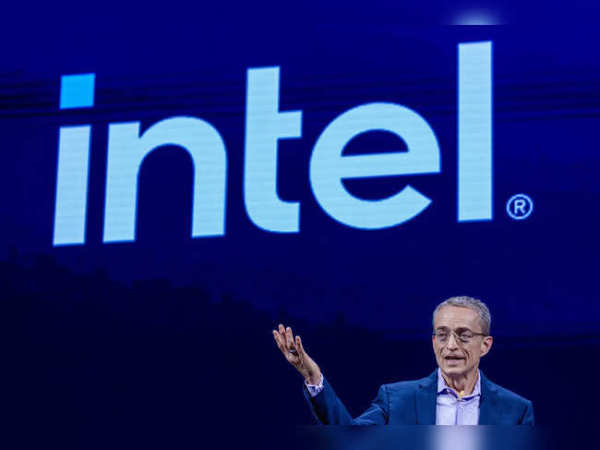They say if there’s ever a Silicon Valley Mount Rushmore, the first face to be chiseled into the stone would be that of Gordon Moore. The Intel Corp. co-founder’s famous prediction about the rate at which semiconductors would improve has provided the bedrock to American technology leadership.
Such sentimentality around Intel and its unparalleled contribution to the computing revolution is what makes any suggestion of a takeover a huge story. The approach by Qualcomm Inc., reported late last week, comes as Intel faces the toughest period in its 56-year history.
In its weakened state — shares are down 53% this year — it is vulnerable to the disruptive effects of window-shopping by rivals that are currently more prosperous.
Intel Chief Executive Officer Pat Gelsinger should tune out the noise and stick to his turnaround strategy.
Most analysts consider the deal unlikely to progress much further. Aside from the simple question of how Qualcomm would actually pay for it, there are other huge hurdles, particularly concerning regulatory approval. The merger of two huge US chip companies with a combined market value of $283 billion isn’t something that will be allowed to happen quickly — if at all.
We also know little of the precise nature of Qualcomm’s interest. Reports a month ago suggested the company was most keen on buying Intel’s chip-design arm but not the manufacturing business. That wouldn’t be surprising: Intel’s chips still do well in the PC sector and also in data servers, which would complement Qualcomm’s position in the mobile market and give it a quick market share boost.
In contrast, taking on chip foundries would be a huge burden — they are extremely expensive, and Intel’s plans still require billions of dollars of investment if it’s to regain ground lost to Taiwan Semiconductor Manufacturing Co.
That’s why the more recent reports suggesting Qualcomm might want to buy Intel in its entirety has analysts scratching their heads. Why would Qualcomm make Intel’s huge challenges its own?
Meanwhile, Qualcomm’s reported pitch of an “all-American” merger to US regulators has some merit — this is about remaining competitive globally — but that ignores how other regions would view the union of two of the world’s largest chipmakers, even with Intel in its distressed state.
The saga of Intel’s struggles has become just as famous as its origin story. Its early dominance in PCs led to complacency; the company famously turned down the chance to develop a chip for the iPhone. Then it allowed its manufacturing abilities to fall behind those of TSMC. Now Intel is trailing the likes of Nvidia Corp. and others on artificial intelligence. This year, Intel is on course for a third consecutive year of declining revenue. Such is the cost of missed opportunities.
But the story isn’t over. Revenue growth is projected to return in 2025 as Gelsinger’s turnaround plan starts to bear fruit. It includes cutbacks, with 15,000 employees losing their jobs, and delays in factory construction in Germany and Poland, perhaps indefinite.
More significant, the company is spinning out its foundry business to make it more appealing to the fabless chipmakers, which now turn to TSMC when they want their designs manufactured.
Detailed in full for the first time last week, Gelsinger’s good ideas received investor approval as a strong — if expensive — strategy to claw back some of the ground Intel has lost over the past two decades. An “equity-like” investment offer of up to $5 billion from Apollo Global Management, first reported on Sunday by Bloomberg, would be further incentive for Intel to stay on track rather than let itself be sold for parts.
There are glimmers of momentum. Last week, Intel and Amazon.com Inc. announced they had reached a deal for Intel’s foundry to make custom AI chips for Amazon Web Services, the world’s largest cloud-computing provider. The deal in itself won’t resurrect Intel’s fortunes, noted analyst Ben Thompson, but it could form the basis for a long-running and lucrative partnership in the blossoming AI industry.
Intel has also said that it could be in line for $3 billion from the US government to make chips for the so-called Secure Enclave, a defense and intelligence project. This gets to the heart of why Intel’s turnaround is so important. The goals of the US Chips and Science Act, to reduce chip supply-chain exposure to the whims of China, rests significantly on Intel being nursed back to health — which is why the company has been earmarked for some $8.5 billion in grants and subsidies.
The national interest is best served by an Intel nursed back to strength. Disruption from a possible takeover would slow down this vital work. Rebuilding US chipmaking capability is already taking long enough.
Gelsinger’s time, then, is best spent executing on his plan and building a client base for the foundry business. As he said in a Bloomberg interview recently: “I need lots of customers.” Quite. What he doesn’t need, it’s clear, is a buyer.
Such sentimentality around Intel and its unparalleled contribution to the computing revolution is what makes any suggestion of a takeover a huge story. The approach by Qualcomm Inc., reported late last week, comes as Intel faces the toughest period in its 56-year history.
In its weakened state — shares are down 53% this year — it is vulnerable to the disruptive effects of window-shopping by rivals that are currently more prosperous.
Intel Chief Executive Officer Pat Gelsinger should tune out the noise and stick to his turnaround strategy.
Most analysts consider the deal unlikely to progress much further. Aside from the simple question of how Qualcomm would actually pay for it, there are other huge hurdles, particularly concerning regulatory approval. The merger of two huge US chip companies with a combined market value of $283 billion isn’t something that will be allowed to happen quickly — if at all.
We also know little of the precise nature of Qualcomm’s interest. Reports a month ago suggested the company was most keen on buying Intel’s chip-design arm but not the manufacturing business. That wouldn’t be surprising: Intel’s chips still do well in the PC sector and also in data servers, which would complement Qualcomm’s position in the mobile market and give it a quick market share boost.
In contrast, taking on chip foundries would be a huge burden — they are extremely expensive, and Intel’s plans still require billions of dollars of investment if it’s to regain ground lost to Taiwan Semiconductor Manufacturing Co.
That’s why the more recent reports suggesting Qualcomm might want to buy Intel in its entirety has analysts scratching their heads. Why would Qualcomm make Intel’s huge challenges its own?
Meanwhile, Qualcomm’s reported pitch of an “all-American” merger to US regulators has some merit — this is about remaining competitive globally — but that ignores how other regions would view the union of two of the world’s largest chipmakers, even with Intel in its distressed state.
The saga of Intel’s struggles has become just as famous as its origin story. Its early dominance in PCs led to complacency; the company famously turned down the chance to develop a chip for the iPhone. Then it allowed its manufacturing abilities to fall behind those of TSMC. Now Intel is trailing the likes of Nvidia Corp. and others on artificial intelligence. This year, Intel is on course for a third consecutive year of declining revenue. Such is the cost of missed opportunities.
But the story isn’t over. Revenue growth is projected to return in 2025 as Gelsinger’s turnaround plan starts to bear fruit. It includes cutbacks, with 15,000 employees losing their jobs, and delays in factory construction in Germany and Poland, perhaps indefinite.
More significant, the company is spinning out its foundry business to make it more appealing to the fabless chipmakers, which now turn to TSMC when they want their designs manufactured.
Detailed in full for the first time last week, Gelsinger’s good ideas received investor approval as a strong — if expensive — strategy to claw back some of the ground Intel has lost over the past two decades. An “equity-like” investment offer of up to $5 billion from Apollo Global Management, first reported on Sunday by Bloomberg, would be further incentive for Intel to stay on track rather than let itself be sold for parts.
There are glimmers of momentum. Last week, Intel and Amazon.com Inc. announced they had reached a deal for Intel’s foundry to make custom AI chips for Amazon Web Services, the world’s largest cloud-computing provider. The deal in itself won’t resurrect Intel’s fortunes, noted analyst Ben Thompson, but it could form the basis for a long-running and lucrative partnership in the blossoming AI industry.
Intel has also said that it could be in line for $3 billion from the US government to make chips for the so-called Secure Enclave, a defense and intelligence project. This gets to the heart of why Intel’s turnaround is so important. The goals of the US Chips and Science Act, to reduce chip supply-chain exposure to the whims of China, rests significantly on Intel being nursed back to health — which is why the company has been earmarked for some $8.5 billion in grants and subsidies.
The national interest is best served by an Intel nursed back to strength. Disruption from a possible takeover would slow down this vital work. Rebuilding US chipmaking capability is already taking long enough.
Gelsinger’s time, then, is best spent executing on his plan and building a client base for the foundry business. As he said in a Bloomberg interview recently: “I need lots of customers.” Quite. What he doesn’t need, it’s clear, is a buyer.








